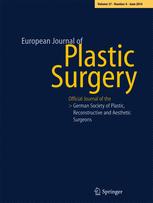
Reporting quality among RCTs in plastic surgery is low and in need of improvement

Reporting quality among RCTs in plastic surgery is low and in need of improvement
Randomised controlled trials in plastic surgery: a systematic review of reporting quality
Eur J Plast Surg. 2014;37:55-62. Epub 2013 Oct 30.Did you know you're eligible to earn 0.5 CME credits for reading this report? Click Here
Synopsis
57 randomized controlled trials (RCTs) pertaining to plastic surgery research (from 28 journals) were included in this systematic review. The purpose of this study was to determine the overall reporting quality among these RCTs. Results indicated that the median CONSORT score was low (11.5/23), however there is a general trend of improvement over time. There was no correlation between CONSORT score and either the number of authors (Spearman rho=0.12), the journal's impact factor (Spearman rho=0.26) or the geographical origin of the RCT.
Were the search methods used to find evidence (original research) on the primary question or questions stated?
Was the search for evidence reasonably comprehensive?
Were the criteria used for deciding which studies to include in the overview reported?
Was the bias in the selection of studies avoided?
Were the criteria used for assessing the validity of the included studies reported?
Was the validity of all of the studies referred to in the text assessed with use of appropriate criteria (either in selecting the studies for inclusion or in analyzing the studies that were cited)?
Were the methods used to combine the findings of the relevant studies (to reach a conclusion) reported?
Were the findings of the relevant studies combined appropriately relative to the primary question that the overview addresses?
Were the conclusions made by the author or authors supported by the data and or analysis reported in the overview?
How would you rate the scientific quality of this evidence?
Yes = 1
Uncertain = 0.5
Not Relevant = 0
No = 0
The Reporting Criteria Assessment evaluates the transparency with which authors report the methodological and trial characteristics of the trial within the publication. The assessment is divided into five categories which are presented below.
3/4
Introduction
4/4
Accessing Data
3/4
Analysing Data
2/4
Results
3/4
Discussion
Detsky AS, Naylor CD, O'Rourke K, McGeer AJ, L'Abbé KA. J Clin Epidemiol. 1992;45:255-65
The Fragility Index is a tool that aids in the interpretation of significant findings, providing a measure of strength for a result. The Fragility Index represents the number of consecutive events that need to be added to a dichotomous outcome to make the finding no longer significant. A small number represents a weaker finding and a large number represents a stronger finding.
Why was this study needed now?
In 2008, The Consolidated Standards of Reporting Trials (CONSORT) guidelines for non-pharmacological interventions were released to improve and standardize reporting among randomized controlled trials in the literature. It has previously been found that, among randomized controlled trials in the field of plastic surgery, there is room for improvement in regards to methodological quality. However, to date, reporting quality among plastic surgery research papers has not yet been systematically reviewed, emphasizing the need for this study.
What was the principal research question?
What is the overall reporting quality among randomized controlled trials in plastic surgery research?
What were the important findings?
- 57 randomized controlled trials from 28 journals were included in this review. Among these RCTs, 7 were multi-centre studies.
- The median CONSORT score was 11.5/23 (range: 4.5-21.0), with a Kappa score of 0.80.
- Median consort scores were 9.9 in 2009, 11.5 in 2010 and 12.9 in 2011, displaying a trend towards improvement in overall reporting quality over time.
- Compliance for the standard CONSORT criteria were lowest for intervention/comparison details (7%), randomization (11%) and blinding (26%).
- In regards to additional CONSORT criteria, 61% of studies stated potential conflict of interest, 75% reported details regarding ethical approval, 47% reported sources of funding, and 16% identified a trial registry number.
- There was no correlation between CONSORT score and either the number of authors (Spearman rho=0.12), the journal's impact factor (Spearman rho=0.26) or the geographical origin of the RCT.
What should I remember most?
In general, reporting quality was poor (11.5/23) among randomized controlled trials pertaining to plastic surgery, however there is a general trend of improvement over time. There was no correlation between CONSORT score and either the number of authors (Spearman rho=0.12), the journal's impact factor (Spearman rho=0.26) or the geographical origin of the RCT.
How will this affect the care of my patients?
The results from this study suggest that, although there are improvements as time goes on, researchers in the field of plastic surgery should focus on improving the reporting quality of their future studies according to the CONSORT guidelines. As this systematic review only included publications written in English and only up to 2011, additional systematic reviews are needed to monitor any improvement in reporting quality (or lack thereof).
Learn about our AI Driven
High Impact Search Feature
Our AI driven High Impact metric calculates the impact an article will have by considering both the publishing journal and the content of the article itself. Built using the latest advances in natural language processing, OE High Impact predicts an article’s future number of citations better than impact factor alone.
Continue



 LOGIN
LOGIN

Join the Conversation
Please Login or Join to leave comments.